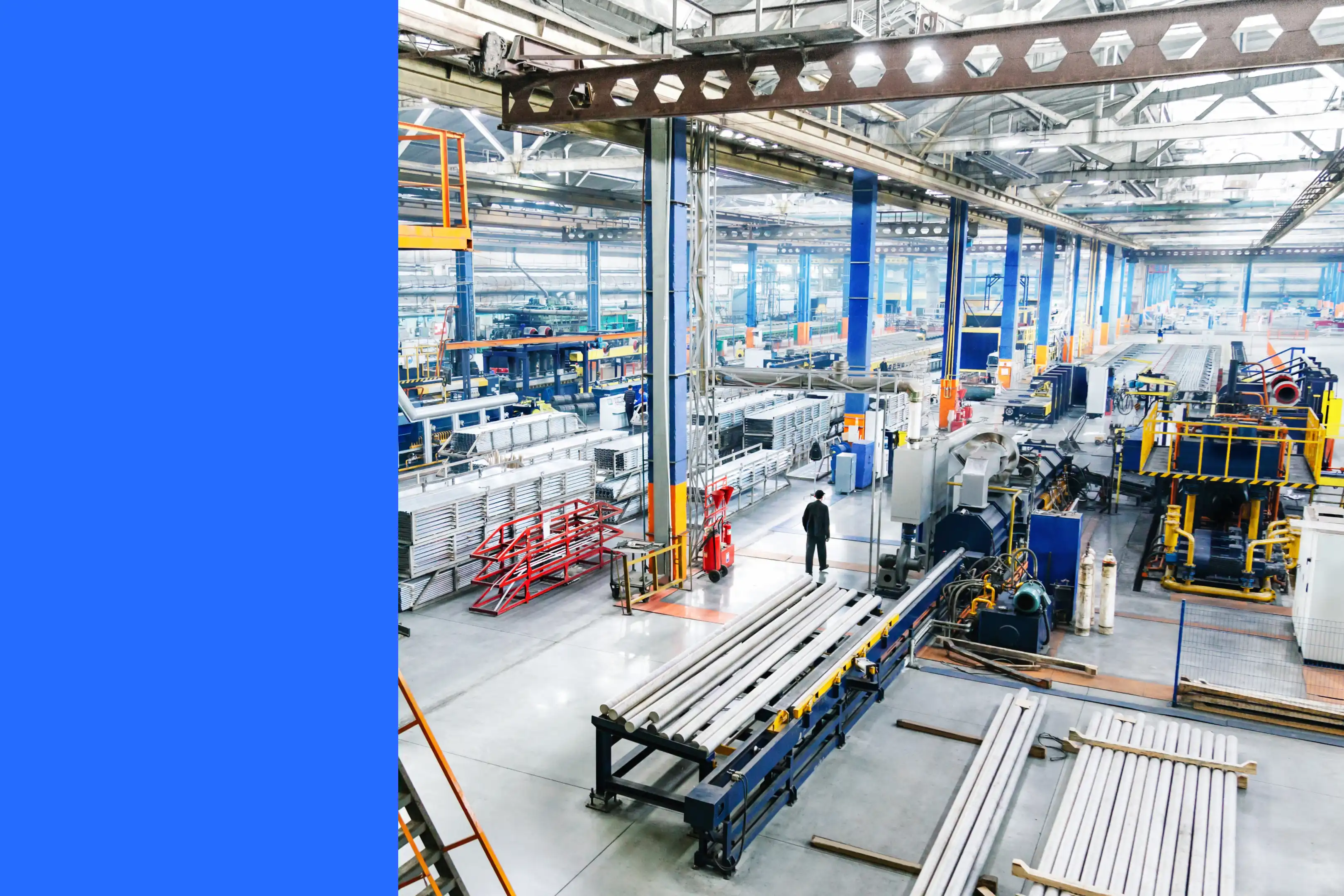
At 9:12 a.m., a vibration alert crosses a warning threshold on a critical motor. What happens next?
With a modern Enterprise Asset Management (EAM) system, the process is seamless:
- The system auto-creates a work order, assigns the right technician, and checks parts availability.
- The technician scans a QR code, follows a guided checklist, and uploads a photo of the worn coupling.
- The planner sees the evidence, the buyer gets a suggested purchase order, and finance sees the cost attached to the correct asset.
The result of having an EAM in place is that your team can fix the motor with minimal downtime. Your org also benefits from traceability and fewer surprises.
What is Enterprise Asset Management (EAM)?
Think of EAM as a single source of truth: asset hierarchies define where work lives, work orders capture what happened, checklists and photos prove how it was done, and analytics reveal where to invest next.
Beyond maintenance work management, EAM also pulls in inventory, vendor contracts, capital planning, and cross-site governance so teams can make decisions with context.
In other words, Enterprise Asset Management benefits teams by connecting the dots across the asset lifecycle into one system: design and commissioning, daily operation, condition monitoring, preventive maintenance, inventory, purchasing, and compliance.
Read on for more EAM benefits and how to determine the ROI of an EAM system.
Key takeaways
- Enterprise asset management benefits: EAM centralizes the full asset lifecycle to help teams cut unplanned downtime, extend asset life, lower maintenance costs, improve safety and compliance, and boost OEE.
- Measure what matters: Track important metrics like MTBF, MTTR, planned work, PM compliance, and stockout rate.
- Prove ROI with a simple formula: (downtime avoided + maintenance savings + inventory savings − EAM cost) ÷ EAM cost
20 Enterprise Asset Management benefits
These EAM benefits cover the outcomes leaders care about most: uptime, cost control, safety and compliance, and decision quality.
- Less unplanned downtime
When assets fail without warning, the costs add up thanks to idle time, missed orders, and overtime to recover. EAM shifts you from firefighting to foresight by standardizing PMs and enabling condition triggers (e.g., runtime hours, vibration). - Longer asset life
Consistent lubrication, alignment, and balancing extend equipment lifespans. With EAM, your team doesn’t miss small PM tasks that make a big difference. The payoff is years gained and capex you don’t need to spend. - Lower maintenance cost per asset/unit
Emergency calls, rush parts, and overtime make reactive work expensive. EAM rebalances toward planned work and cuts expedited shipping fees. - Higher technician productivity
With mobile work orders, barcodes, offline mode, and photo/video instructions, an EAM helps teams spend less time searching for info so their wrench time can go up. - Optimized preventive and predictive maintenance
Not every asset needs a monthly PM. EAM lets you tune intervals by risk and asset criticality and switch to condition-based triggers when data supports it. - Inventory and MRO optimization
Always have the right parts on hand at the right time. EAM enforces min/max, alternates, and supersessions; it uses real consumption data to reduce working capital while preventing stockouts. - Improved OEE
OEE rises when availability stabilizes and stoppages shrink. EAM links failure modes to assets and shifts the focus to “bad actors” driving the most loss. - Safety and compliance
Lockout/tagout steps, PPE requirements, and permits live directly in work orders. Supervisors sign electronically, creating an audit trail that protects people and the business. - Faster audits
Auditors don’t just want to see that you fixed it—they want to see how you fixed it. EAM centralizes manuals, revisions, photos, and approvals in one record that you can access in a few clicks. - Energy and sustainability gains
Misaligned drives, clogged filters, and air leaks quietly burn cash. EAM embeds checks that catch these early. - Work standardization and knowledge capture
Veteran technician know-how becomes institutional know-how. Photos, videos, and checklists make best practices accessible to everyone, so quality doesn’t leave when people retire. - Fewer defects
Quality issues often trace back to asset condition. By stabilizing the process through better maintenance, you can minimize scrap and rework. - Faster Mean Time to Repair (MTTR)
The fastest fix is the one you’re ready to do. EAM kitting, part pre-staging, and guided troubleshooting shave minutes that add up over time. - Better capex planning
Replacement debates get easier when you can point to lifecycle cost curves and an asset health index. EAM gives you the data to choose “repair vs. replace” confidently. - Accurate budget control
When labor, parts, and contractor costs roll up by asset and line, leaders can ask better questions: Which line is burning overtime? Which vendor is over-indexing on rush fees? - Vendor and contractor performance
If you can’t measure it, you can’t manage it. EAM tracks response times, rework, and SLA adherence—fuel for renegotiations or vendor changes. - Planning and scheduling efficiency
EAM helps leaders quickly prioritize by criticality, align skills to jobs, and ensure parts are in hand before the wrench turns. - Cross-team collaboration
Better teamworks starts with a shared, easily accessible dataset and efficient, mobile-first communication tools. - Scalability and multi-site governance
Templates and standards let you roll out wins across sites without reinventing the wheel. - AI-assisted decisions
As your history grows, EAM can suggest likely failure causes, parts, and checklists. AI doesn’t replace your team’s expertise, but it helps them discover problems and patterns faster.
EAM benefits by role
- Finance: EAM makes savings visible: downtime avoided shows up as throughput, maintenance costs become predictable, and inventory releases cash. Capex decisions aren’t made by “feel,” but by analytics grounded in asset health.
- Plant/facilities leaders: A calmer production floor: fewer callouts, clearer priorities, and visible progress on bad actors. Staffing becomes proactive, not reactive.
- Maintenance leaders: Backlogs get right-sized. PMs are evidence-based, techs are empowered, and reports finally reflect the work you know is happening.
- Reliability engineers: High-quality failure codes, condition data, and event histories make root cause analysis possible.
- IT/OT: Secure integrations (ERP/SCADA/BMS), SSO, and data governance anchor the platform in your enterprise architecture.
EAM vs. CMMS vs. ERP: What’s the difference?
A CMMS is excellent at scheduling and tracking maintenance work. EAM does that and adds lifecycle scope, including inventory, purchasing, risk, analytics, and multi-site governance. Meanwhile, ERP is the financial backbone and system of record for purchase orders and general ledger, but it typically doesn’t capture the operational context of assets.
Use EAM when you need cross-site standards, asset strategy, and capital planning. Use ERP and EAM together when financial control and operational context both matter.
How to prove EAM ROI
The most persuasive ROI stories won’t necessarily involve the biggest numbers. First, focus on thoroughly documenting small wins.
- Baseline the first 90 days. Lock in unplanned downtime hours, maintenance spend, overtime, and inventory carrying cost.
- Tie improvements to money. Convert hours to currency with a defensible cost/hour. Apply a conservative carrying rate (e.g., 20–25%) to inventory reductions.
- Report quarterly. Keep the math simple and consistent so finance can audit it.
Core formulas
- Downtime cost avoided = (Historical Unplanned Downtime − Current) × Cost/Hour
- Maintenance cost savings = Historical Maintenance Cost − Current Maintenance Cost
- Inventory carrying savings = (Historical Inventory Value − Current) × Carrying Rate
- EAM ROI = (Downtime Avoided + Maintenance Savings + Inventory Savings − EAM Cost) ÷ EAM Cost
Conservative year-1 example
- Unplanned downtime reduced by 120 hours; cost/hour $5,000 → $600,000 avoided
- Maintenance cost down $180,000 (less overtime, fewer rush fees)
- Inventory carrying savings $60,000
- EAM subscription + implementation $150,000
- ROI = ($600k + $180k + $60k − $150k) ÷ $150k = 4.6× (460%)
Note: If you only track five metrics, start with MTBF, MTTR, % planned work, PM compliance, and stockout rate. Learn more about choosing the right KPIs here.
90-Day EAM rollout plan
Rolling out EAM doesn’t have to be complicated. This 90-day plan breaks the work into three simple steps: set things up, get people using it, and show the wins. Each step spells out what to do and which numbers to watch (like downtime and on-time maintenance) so you can prove it’s working and earn the go-ahead to expand.
Days 1–30: Foundation
- People and cadence: Appoint a project owner, weekly status meeting, and an executive sponsor who removes blockers.
- Standards: Agree on asset hierarchy, criticality scoring, and naming. Import assets, parts, and vendors; clean obvious duplicates.
- Work basics: Digitize the top 20 PMs with photos, torque values, and safety steps. Pilot on one line with your most coachable crew.
- Mobile first: Enable barcode/QR and offline mode. Audit that every pilot tech can open, complete, and sign a work order without help.
Days 31–60: Work management
- From reactive to planned: Convert the top emergency causes into planned work or condition triggers.
- Inventory discipline: Set min/max on A and B parts; turn on low-stock alerts; create substitution rules.
- Integration basics: Feed runtime or alarms from PLC/SCADA/BMS into EAM to trigger work automatically.
Days 61–90: Prove the value
- Reliability tagging: Enforce failure codes (cause/remedy) on every corrective work order.
- Bad actors: Run a Pareto chart on downtime by asset; focus on 3–5 assets with clear actions.
- Executive review: Report MTBF, MTTR, % planned, PM compliance, and stockouts with before/after context. Ask for budget to expand.
Mitigate risks
- Adoption stalls: Use floor walks and peer champions; make it easier to do the right thing than to skip steps.
- Too much at once: Keep scope small, wins visible, and iterate.
Buyer’s checklist: Questions to ask EAM vendors
Choosing an EAM is easier when every vendor answers the same questions. Use the list below in your next call: ask how techs do the work day-to-day, how parts are kept in stock, how alerts turn into jobs, how it connects to your current systems, and how quickly you can expect to see results.
- Can techs complete work offline on mobile with photos and signatures?
Plants and facilities aren’t always connected. If work pauses without WiFi, technicians won’t find the system useful. - Do you support condition-based PMs from meters/IoT?
Time-based PMs alone can create waste. Condition triggers capture true equipment health. - Security and governance: SSO, roles, audit trails, e-signatures?
Enterprise scale demands control—who did what, when, and with whose approval. - Integrations (ERP, SCADA)?
Your EAM should be able to sync with key systems your team already uses. - Analytics: MTBF, MTTR, OEE?
The right dashboards should help you answer “What should we do next?” - Implementation pattern and typical time-to-value?
Look for a delivery plan that gets real KPIs moving in weeks. - Multi-site templates and governance model?
Standardize what should be shared; leave room for local nuance. - Evidence of results (case studies)?
Ask for before/after stories from companies with similar goals.
Why MaintainX for EAM?
MaintainX is loved by users for being mobile-first, built to scale, and quick to implement. It also provides customizable integrations so you can keep your key systems in sync.
Want to see how the platform can benefit your operations? See a demo or check out our customer success stories.
FAQs
What are the top enterprise asset management benefits?
Some of the top benefits of an EAM platform include reduced unplanned downtime, longer asset life, lower maintenance costs, optimized inventory, higher technician productivity, stronger compliance and safety, faster audits, better OEE, and cross-team collaboration. Together, these EAM benefits stabilize operations and build a system for continuous improvement.
How is EAM different from CMMS?
A CMMS manages maintenance work—great for scheduling PMs and tracking labor/parts. EAM covers the entire asset lifecycle, pulling in inventory, purchasing, vendor management, reliability analytics, and capital planning. As organizations scale across sites, EAM’s broader scope prevents silos and duplicate efforts.
Which industries get the most value from EAM?
Manufacturing, facilities management, utilities, healthcare, transportation, and the public sector see outsized gains because asset uptime links directly to service levels, safety, and revenue. Where assets are mission-critical, the EAM benefits compound quickly.
How quickly can we see EAM benefits and ROI?
Many teams see leading indicators—higher PM compliance, more planned work, lower MTTR—within the first few weeks after implementation. Cash-impacting results (downtime reductions, overtime decreases, inventory turns) usually show up within a quarter, provided adoption is strong and the rollout stays focused.
Does EAM help with audits and compliance?
Yes. Digital work histories, standardized procedures, and e-signatures reduce audit prep time. Auditors care about consistency and traceability. EAM makes both easy to demonstrate.


.webp)
.webp)

